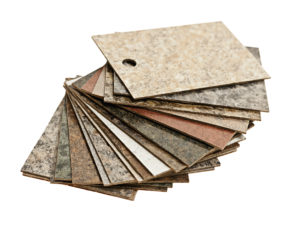
One of the most common questions you will face when renovating or building a home is what type of material to use for countertops. And it’s a great question. There are nearly 20 different types of material, all ranging in price and look and each having their own benefits, applications, and quality. Some materials are new to the market and some have been around for years, but one material that has been with us for a while is seeing new and dramatic improvements in styling and quality. That material is laminate. It provides multiple benefits that continue to make it one of the most popular materials on the market.
To help make your homework easy, we are listing here the 5 most asked questions about laminate. You’ll gain a good understanding of what this material can offer and if it is right for your next project.
.
- What is laminate?
The process of laminating is a technique of manufacturing where multiple layers of material are combined to create added strength and stability. The material is adhered through methods such as heading, welding, or the use of adhesives. In the case of laminate countertops, layers are composed of plastic and bonded to particleboard or kraft paper to create a solid surface. It is then covered in a permanent seal for protection. These countertops are used on nearly any surface where you need strength and added protection during heavy use. Outside of countertops, laminate is also one of the most common materials in home flooring and furniture construction such as desks, dining tables, nightstands, and practically any a case good.
- What are the design benefits of laminate?
Laminate can be designed into many patterns including competing materials such as wood, granite, marble, and even stainless steel. And each year the designs get better. You can install tops with dramatic and engaging ribbon patterns of Calacatta marble. Whatever stone you desire, the new laminates can duplicate them. It’s a whole new world.
This material can also be made into large sheets, making it different from natural materials such as wood, marble, and tile which all have size limitations. This allows for cleaner applications on counters and backsplashes for an ultra-clean look. Cutting and seaming are important considerations any discriminating homeowner who loves natural materials will face, but it’s not as challenging with laminate. You can have larger sheets and better flexibility in matching and grouping patterns together.
- How does the cost of laminate compare to other materials?
With all of the design options available with laminate, an even more significant benefit is the price point. Laminate is the lowest price of all the counter materials on the market, making it appealing for homeowners on a budget and for larger residential projects such as multi-home construction and multi-unit apartments, townhomes, condominiums, and hotels. If we look at pricing from lowest to highest, laminate sits at #1 followed by tile, bamboo, solid surfaces (acrylics and polyesters), granite, slate, travertine, recycled glass, limestone, engineered quartz, butcher block, soapstone, porcelain, marble, concrete, stainless steel, reclaimed wood, and lavastone.
The benefit of its low cost means you can easily update your kitchen or bathroom for an enhanced daily experience. You can also make your home more appealing to potential buyers. With the quality of laminate styles improving each year, a new owner will be more prone to leaving it in, making your home more valuable on the market in terms of price and ease-of-use.
- How durable is it?
Durability is an important consideration when factoring your kitchen countertops. Laminate is heat and stain resistant and the newest styles also rate well against cutting, but if you are prone to heavy knife usage on countertops you may want to buy a cutting board. There are other materials that exceed in durability and performance, but laminate succeeds in being the best combination of durability and value, exceeding in quality to higher priced materials such as solid surfaces, recycled glass, and butcher block. Day-in and day-out care requirements are also minimal. Damage to the material can happen and if the seal is cracked the counter will need to be replaced, but a well-cared-for top can last a good 10 years or more.
- What maintenance is required?
Laminate countertops are one of the easiest materials to maintain. In most occurrences, you only need a damp cloth and mild liquid detergent or household cleaner. You can also use a soft brush on the seams. Bleach is to be avoided since it can cause discoloration.
One of the best traits of laminate is that it doesn’t require maintenance such as reapplication of sealers, which can be frustrating for homeowners. Materials such as granite and marble need to be cleaned, resealed, and polished at least once a year. The new designs of laminate give you the same look as these materials without the high maintenance.
The list of benefits of laminate is long: it is low-cost, low maintenance, increasingly better looking and provides a cleaner application. These traits make laminate countertops a popular choice for remodels or construction work, improving the look of a home at a low cost for better resale value. If you don’t plan to put your home on the market, it’s a strong option of durability and value that dramatically improves the look of your home. One important factor to consider is the amount of usage you expect to see in the kitchen; this way you make the right decision for years to come.
Have more questions? Want to see samples and ideas? Stop by our showroom in Green Bay, Wisconsin and ask the experts at Top Shop Countertops. We are located at 2170 Speaker Court, and are always happy to assist you with your projects, residential or business. Laminate countertops, among other countertop substrates are our expertise, and we are glad to educate you and help you implement your ideas.
